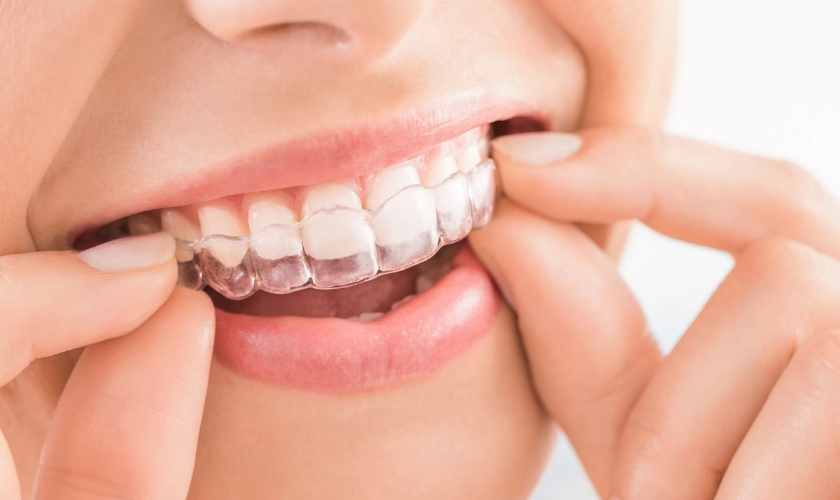Book An Appointment

The journey to a straighter smile with Invisalign is exciting, but there can be some bumps along the way. One common concern is gum irritation or even cuts caused by the aligners. While this can be frustrating, it’s important to remember that it’s usually temporary, and there are solutions to find relief. Here’s a guide to help you navigate this discomfort and ensure your Invisalign journey stays smooth.
Understanding the Cause
While clear aligners, like Invisalign, are generally comfortable, they can occasionally cause cuts or irritation to the gums. Here are some common reasons why this might happen and what you can do to address them:
Imperfect Fit
Aligners are custom-made, but slight variations during production or changes in your teeth during treatment can lead to a less-than-perfect fit. This can cause the aligners to rub against your gums unevenly, causing irritation and potential cuts.
Sharp Edges
Sometimes, when trimming aligners at home, you leave behind sharp edges. These sharp edges can scratch and cut your gums if not smoothed out properly.
New Aligner Adjustment
When you switch to a new aligner tray, it applies gentle pressure to move your teeth into their desired positions. This pressure can cause temporary discomfort, including gum sensitivity and slight cuts, especially in the first few days of wearing the new tray.
Finding Relief from Invisalign Discomfort
While experiencing temporary discomfort is a normal part of the Invisalign journey, it doesn’t have to be a constant struggle. Here are some effective ways to manage discomfort and keep your smile on track, always remembering to consult your orthodontist for any persistent issues:
Your Comfort Kit Essentials
Orthodontic Wax: This is your go-to for addressing irritation caused by the aligners rubbing against your gums. Apply a small amount directly on the bothersome area to create a protective barrier and prevent further discomfort.
Strategic Tray Changes: The initial pressure and tightness are typically most pronounced within the first two days of wearing a new aligner set. To ease into this adjustment period, consider changing your aligners before bedtime. This allows your teeth and gums to adapt gradually while you sleep.
Over-the-counter pain relievers: When mild pain or inflammation arises, over-the-counter pain relievers like ibuprofen or acetaminophen can offer temporary relief. Always adhere to the recommended dosage instructions and consult your doctor if you have any concerns about using these medications.
Soothing Saltwater Rinse: A warm saltwater rinse made with half a teaspoon of salt dissolved in a glass of warm water can be a gentle and effective way to soothe irritated areas and promote healing. Rinse your mouth thoroughly several times a day for added comfort.
Cold Compress Magic: Applying a cold compress to the outside of your cheek for 15-20 minutes at a time, several times a day, can help reduce swelling and alleviate discomfort. The coolness numbs the area and helps manage any inflammation.
Maintaining a Healthy Smile
Consistent brushing (twice daily) and flossing (once daily) are crucial throughout your Invisalign treatment. Food particles can easily get trapped under the aligners, increasing the risk of plaque buildup and gum inflammation. Meticulous oral hygiene helps prevent these issues and keeps your breath fresh. Rinsing with water after meals and throughout the day helps dislodge food particles stuck under the aligners and prevents bad breath. You can also use a mild mouthwash (consult your dentist for recommendations) for additional cleaning, but avoid harsh mouthwashes that can discolor your aligners.
Optimizing Your Treatment
It’s essential to wear your aligners for the prescribed amount of time each day, typically around 22 hours. Skipping wear time or not wearing them for the recommended duration can significantly hinder your treatment progress. Consistent wear ensures your teeth move according to the treatment plan and prevents delays or complications. Carefully follow your dentist’s instructions regarding changing your aligners, cleaning them, and addressing any concerns. Regular checkups are also crucial to monitor your progress and ensure your treatment stays on track.
Experiencing gum cuts while wearing Invisalign doesn’t have to derail your progress. By understanding the causes, implementing these simple solutions, and maintaining open communication with your orthodontist, you can navigate this temporary discomfort and get back to enjoying your journey. Remember, a little patience and proactive care can go a long way in ensuring a smooth and successful Invisalign experience.





